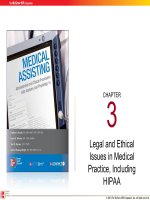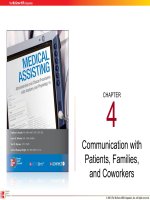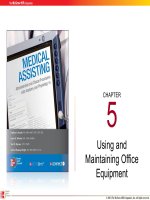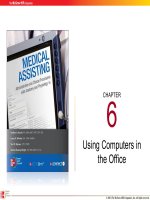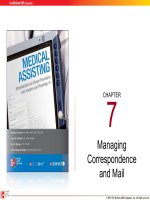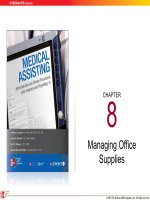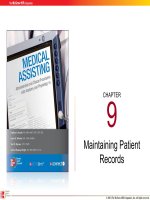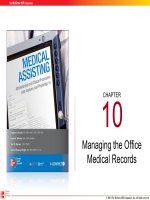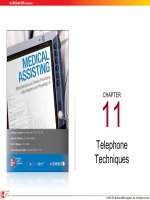Lecture Medical assisting: Administrative and clinical procedures with anatomy and physiology (4/e) – Chapter 24
Bạn đang xem bản rút gọn của tài liệu. Xem và tải ngay bản đầy đủ của tài liệu tại đây (1.02 MB, 45 trang )
CHAPTER
24
The Respiratory
System
© 2011 The McGraw-Hill Companies, Inc. All rights reserved.
242
Learning Outcomes
24.1 Explain the functions of the respiratory
system.
24.2 Explain the difference between internal
respiration and external respiration.
24.3 Describe how the larynx produces voice
sounds.
24.4 List the structures contained within the lungs.
24.5 Describe the coverings of the lungs and
chest cavity.
© 2011 The McGraw-Hill Companies, Inc. All rights reserved.
243
Learning Outcomes (cont.)
24.6 Describe the events that lead to the
inspiration and expiration of air.
24.7 Explain how the brain controls breathing and
how normal breathing patterns can be
disrupted.
24.8 Describe how oxygen is transported from the
lungs to body cells.
© 2011 The McGraw-Hill Companies, Inc. All rights reserved.
244
Learning Outcomes (cont.)
24.9 Describe how carbon dioxide is transported
from body cells to the lungs.
24.10List and explain various respiratory volumes
and tell how they are used to diagnose
respiratory problems.
24.11Describe the causes, signs and symptoms,
and treatments of various diseases and
disorders of the respiratory system.
© 2011 The McGraw-Hill Companies, Inc. All rights reserved.
245
Introduction
• Function
– Move air in and out of lungs (ventilation)
– Delivers oxygen (O2)
– Removes carbon dioxide (CO2)
CO2
• External respiration
O2
– Occurs in the lungs
• Internal respiration
– Occurs in the hemoglobin
O2
Lungs
CO2
CO2
O2
© 2011 The McGraw-Hill Companies, Inc. All rights reserved.
246
Organs of the Respiratory System
Nose
Pharynx
Larynx
Trachea
Bronchial tree
Lungs
© 2011 The McGraw-Hill Companies, Inc. All rights reserved.
247
Nasal Cavity
• Nasal septum divides the cavity into right and
left portions
– Nares – openings of the nose
• Nasal conchae extend from walls of nasal
cavity
• Mucous membrane warms and moistens the air
• Cilia help eliminate particles
© 2011 The McGraw-Hill Companies, Inc. All rights reserved.
248
Paranasal Sinuses
• Air-filled spaces within
the skull bones
– Open into the nasal
cavity
• Reduce the weight of
the skull
• Equalize pressure
• Give the voice its
certain tone
• Skull bones with
sinuses include:
–
–
–
–
Frontal
Sphenoid
Ethmoid
Maxillae bones
© 2011 The McGraw-Hill Companies, Inc. All rights reserved.
249
Pharynx and Larynx
•
Pharynx
– Serves both the respiratory and digestive systems
• Larynx
– Also called the “voice box”
– Moves air in and out of the trachea and
produces voice
– Composed of three cartilages:
• Thyroid cartilage
• Epiglottic cartilage
• Cricoid cartilage
© 2011 The McGraw-Hill Companies, Inc. All rights reserved.
2410
Vocal Cords
• Stretched between the
thyroid cartilage and
the cricoid cartilage
• Upper – false cords
• Lower – true vocal
cords
• Glottis – the opening
between the vocal
cords
• Stretch = pitch of
voice
Posterior
Portion of
Tongue
False
Vocal
Cords
Glottis
True
Vocal
Cords
© 2011 The McGraw-Hill Companies, Inc. All rights reserved.
2411
Trachea
• Referred to as the windpipe
• Tubular organ made of rings of
cartilage and smooth muscle
• Extends from the larynx to the
bronchi
• Lined with cells possessing
cilia (microscopic hair-like projections)
Trachea
Cilia move mucus up to the throat, where
it is swallowed. Smoking destroys cilia.
© 2011 The McGraw-Hill Companies, Inc. All rights reserved.
2412
Bronchial Tree
• Bronchi
– Primary: First
branches off
trachea
– Secondary
– Tertiary
Bronchi
• Bronchioles
– Branch off tertiary
bronchi
Bronchioles
© 2011 The McGraw-Hill Companies, Inc. All rights reserved.
2413
Bronchial Tree (cont.)
• Alveoli
– Thin sacs of cells
surrounded by
capillaries
– Secrete surfactant
• Fatty substance
• Helps maintains the
inflation of the
alveoli between
inspirations
© 2011 The McGraw-Hill Companies, Inc. All rights reserved.
2414
Lungs
• Cone-shaped organs
• Right lung – three lobes
• Left lung – two lobes
• Pleura – membranes surrounding the
lungs
The lungs contain connective tissue, the bronchial
tree, nerves, lymphatic vessels, and blood vessels.
© 2011 The McGraw-Hill Companies, Inc. All rights reserved.
2415
Apply Your Knowledge
Which of the following sites would be the most
lethal if obstructed by a foreign body?
ANSWER:
a. Right bronchus
b. Left bronchus
c. Trachea
© 2011 The McGraw-Hill Companies, Inc. All rights reserved.
2416
The Mechanisms of Breathing
Expiration
Inspiration
Air rich in O2 enters the lungs
from the atmosphere
Air rich in C02 exits the lungs
The diaphragm contracts or
flattens
The diaphragm relaxes
The intercostal muscles lower
the ribs
The intercostal muscles raise
the ribs
Breathing, or pulmonary ventilation, consists of inspiration
(inhalation) and expiration (exhalation).
© 2011 The McGraw-Hill Companies, Inc. All rights reserved.
2417
The Mechanisms of Breathing (cont.)
• Respiratory center
of the brain
• Other factors
– CO2 levels in the blood
– Medulla oblongata –
controls rhythm and
depth of breathing
– pH of the blood
– Pons – controls the
rate of breathing
– Inflation reflex
– Fear and pain
© 2011 The McGraw-Hill Companies, Inc. All rights reserved.
2418
The Mechanisms of Breathing (cont.)
• Causes of altered breathing patterns
– Coughing
– Sneezing
– Laughing
– Crying
– Hiccups
– Yawning
– Speaking
© 2011 The McGraw-Hill Companies, Inc. All rights reserved.
2419
Apply Your Knowledge
Indicated whether each statement refers to (I) inhalation or
(E) exhalation:
ANSWER:
E The intercostal muscles lower the ribs
__
I The diaphragm contracts or flattens
__
I The intercostal muscles raise the ribs
__
E The diaphragm relaxes
__
I Air rich in O2 enters the lungs from the atmosphere
__
E Air rich in C0 exits the lungs
__
2
© 2011 The McGraw-Hill Companies, Inc. All rights reserved.
The Transport of Oxygen and Carbon Dioxide
in the Blood
•
2420
Most of the oxygen
binds to hemoglobin
– Oxyhemoglobin
– Bright red in color
•
Some oxygen remains
dissolved in plasma
• If CO2 combines with hemoglobin at O2
sites, it forms carboxyhemoglobin
© 2011 The McGraw-Hill Companies, Inc. All rights reserved.
The Transport of Oxygen and Carbon Dioxide
in the Blood (cont.)
•
2421
Carbon dioxide gets into the bloodstream
– Reacts with water in plasma and forms
carbonic acid
– Carbonic acid ionizes and releases hydrogen
and bicarbonate ions
– Bicarbonate ions attach to hemoglobin
•
Exhaled as waste product in the lungs
© 2011 The McGraw-Hill Companies, Inc. All rights reserved.
2422
Apply Your Knowledge
Describe what happens to carbon dioxide in the
blood.
ANSWER: Carbon dioxide can combine with hemoglobin
and form carboxyhemoglobin. Most reacts with water in
plasma to form carbonic acid. The carbonic acid ionizes
and releases hydrogen and bicarbonate ions. The
bicarbonate ions then attach to hemoglobin and are
exhaled as a waste product from the lungs.
Super!
© 2011 The McGraw-Hill Companies, Inc. All rights reserved.
2423
Respiratory Volumes
• Different volumes of
air move in and out of
lungs with different
intensities of
breathing
• Measured to assess
health of respiratory
system
© 2011 The McGraw-Hill Companies, Inc. All rights reserved.
2424
Respiratory Volumes (cont.)
Tidal
TidalVolume
Volume
Amount of air that moves in or out of the
lungs during a normal breath
Inspiratory
Inspiratory
Reserve
Reserve
Volume
Volume
Amount of air that can be forcefully
inhaled following a normal inhalation
Expiratory
Expiratory
Reserve
Reserve
Volume
Volume
Amount of air that can be forcefully
exhaled following a normal exhalation
© 2011 The McGraw-Hill Companies, Inc. All rights reserved.
2425
Respiratory Volumes (cont.)
Residual
Residual
Volume
Volume
Volume of air that always remains in
the lungs even after a forceful
exhalation
Vital
Vital
Capacity
Capacity
Amount of air that can be forcefully
exhaled after the deepest inhalation
possible
Total
TotalLung
Lung
Capacity
Capacity
The total amount of air the lungs can
hold
© 2011 The McGraw-Hill Companies, Inc. All rights reserved.

